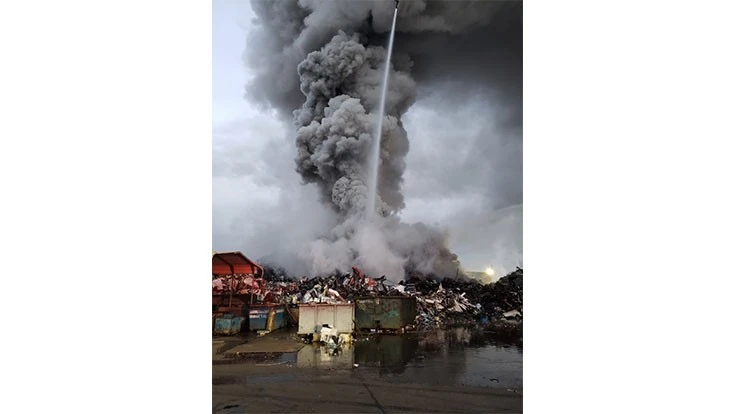
Photo courtesy of Simon Metals
A stockpile at the Simon Metals scrap metal yard in Tacoma, Washington, caught fire at about 2 a.m. on Sept. 17, according to an online report from KIRO 7 news.
The Tacoma yard that caught fire is about 7.5 acres in area. Paul Olsen, president of Simon Metals, says the company has two scrap yards in Washington, including the yard in Tacoma, with a total of 72 employees.
Olsen says a lithium-ion battery likely caused the fire earlier this week. He notes the company received a large load of consumer scrap iron late in the day on Friday, Sept. 14, which likely included a lithium-ion battery.
“People are unaware of these batteries and are getting them into the shredding stream,” he says. “Being it was a weekend and the load came late Friday, the guys sorted the best they could, but missed one [lithium-ion battery]. It got in a pile, made some heat.”
The Sept. 17 fire occurred in a 3,000-pound ferrous stockpile at the scrap yard. Simon Metals employees and the city of Tacoma’s firefighters worked together to put out the fire.
Olsen says it took them about nine hours to contain and put out the fire. He notes that seven fire engines were on site, and the company used about four of its cranes to help grapple the hot material.
“We worked in unison to get it put out,” Olsen says. “We had a baler we had to move out of harm’s way due to the water being used to extinguish the fire. We’re also a Superfund site, so we had to make sure we had zero discharge – the Washington State Department of Ecology was there helping. Overall, the fire department was superb to work with on this, so props to the city of Tacoma fire department.”
Nobody was hurt in the fire, and no equipment was severely damaged. Olsen says the fire had minimal effect on the environment, based on the department of ecology’s investigations, and he says the fire only cost his business about $95,000 to $115,000 in losses. “It wasn’t catastrophic,” he notes.
In recent months, Olsen says Simon Metals has experienced between 10 to 15 smaller fires, but he notes that all of those had occurred during regular work hours.
To deter fires in the future, Olsen says the company is planning to form smaller, isolated piles of materials instead of larger piles. He says the company will also be “picky” with what material it receives.
“We’re going to more closely watch what suppliers bring in,” he says. “We have radiation detectors, but [lithium-ion batteries] can be hard to find. So, suppliers have to isolate them. They have to get the batteries taken care of and out of the supply stream.”
Latest from Recycling Today
- BMW Group, Encory launch 'direct recycling’ of batteries
- Loom Carbon, RTI International partner to scale textile recycling technology
- Goodwill Industries of West Michigan, American Glass Mosaics partner to divert glass from landfill
- CARI forms federal advocacy partnership
- Monthly packaging papers shipments down in November
- STEEL Act aims to enhance trade enforcement to prevent dumping of steel in the US
- San Francisco schools introduce compostable lunch trays
- Aduro graduates from Shell GameChanger program





